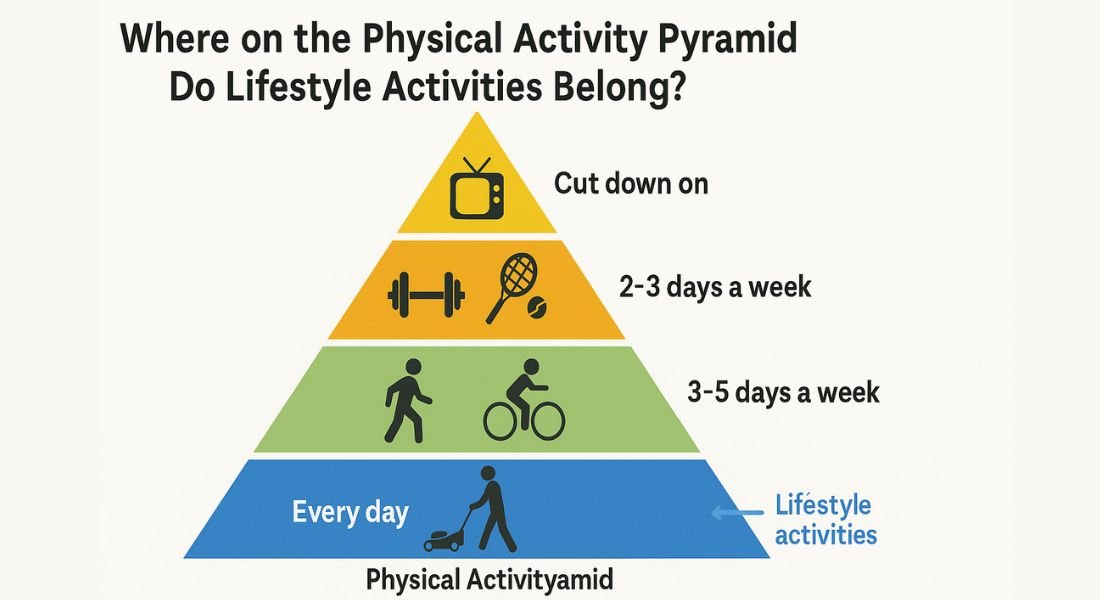The Physical Activity Pyramid is a visual guide that helps individuals understand different types of physical activities and how often they should be performed for optimal health. Similar to the food pyramid, it categorizes exercises based on their intensity and frequency. One common question is: Where do lifestyle activities fit into the physical activity pyramid?
In this article, we will explore the four levels of the Physical Activity Pyramid, discuss where lifestyle activities belong, and examine how regular physical activity can improve life expectancy. We will also look at examples of the pyramid, its relevance for kids, and how different activities fit into its structure.
4 Levels of the Physical Activity Pyramid
The Physical Activity Pyramid consists of four levels, each representing a different category of exercise:
1. Base Level: Lifestyle Activities (Most Frequent)
This level includes moderate-intensity activities that are part of daily life, such as:
- Walking
- Taking the stairs
- Gardening
- Household chores
- Playing with kids or pets
These activities should be done daily because they form the foundation of an active lifestyle.
2. Second Level: Aerobic and Recreational Activities
This level involves more structured exercises that improve cardiovascular health, including:
- Brisk walking
- Jogging
- Swimming
- Cycling
- Dancing
These should be performed 3-5 times per week for at least 30 minutes.
3. Third Level: Strength and Flexibility Exercises
These activities help build muscle strength and flexibility, such as:
- Weightlifting
- Resistance training
- Yoga
- Pilates
These exercises should be done 2-3 times per week.
4. Top Level: Sedentary Activities (Limit These)
The top of the pyramid includes inactive behaviors that should be minimized, such as:
- Watching TV
- Playing video games
- Sitting for long periods
These should be limited to less than 2 hours per day.
Physical Activity Pyramid Example
A typical Physical Activity Pyramid looks like this (from bottom to top):
- Lifestyle Activities (Daily) – Walking, gardening
- Aerobic Exercises (3-5 times/week) – Running, swimming
- Strength & Flexibility (2-3 times/week) – Weight training, yoga
- Sedentary Time (Minimize) – Sitting, screen time
Where Would the Following Activity Best Fit on the Physical Activity Pyramid?
Let’s categorize some common activities:
- Walking the dog → Lifestyle (Base Level)
- Playing basketball → Aerobic (Second Level)
- Lifting weights → Strength Training (Third Level)
- Watching Netflix → Sedentary (Top Level)
The Top of the Physical Activity Pyramid Refers to Which Activity?
The top level represents sedentary behaviors, which should be reduced. Excessive sitting or screen time can lead to obesity, heart disease, and diabetes. Replacing sedentary time with movement is crucial for health.
Physical Activity Pyramid Guide
To follow the pyramid effectively:
- Move more, sit less – Take breaks from sitting.
- Incorporate daily lifestyle activities – Walk instead of drive.
- Schedule aerobic exercises – Aim for 150 minutes/week.
- Include strength training – Prevents muscle loss with age.
- Limit inactivity – Reduce TV and computer time.
Explain How Regular Participation in Physical Activity Can Increase Life Expectancy
Regular physical activity has been proven to extend life expectancy by:
- Reducing Chronic Disease Risk – Lowers chances of heart disease, diabetes, and cancer.
- Improving Heart Health – Strengthens the cardiovascular system.
- Maintaining Healthy Weight – Prevents obesity-related illnesses.
- Boosting Mental Health – Reduces stress, anxiety, and depression.
- Enhancing Mobility & Strength – Prevents falls and fractures in older adults.
Studies show that 30 minutes of daily exercise can add 3-5 years to life expectancy.
Physical Activity Pyramid Photos
Visual guides help people understand how to structure their exercise routines. Many Physical Activity Pyramid images are available online, showing:
- Color-coded levels
- Examples of activities in each category
- Recommended frequency
These images are useful for fitness plans, school programs, and health campaigns.
Physical Activity Pyramid for Kids
Children have different activity needs. A kids’ Physical Activity Pyramid includes:
- Lifestyle Activities – Playing outside, walking to school
- Active Play & Sports – Soccer, tag, swimming
- Flexibility & Strength – Climbing, gymnastics
- Limited Screen Time – Less than 1-2 hours/day
Kids should get at least 60 minutes of active play daily.
Conclusion
Lifestyle activities belong at the base of the Physical Activity Pyramid because they are the foundation of daily movement. By following the pyramid’s structure—balancing aerobic exercise, strength training, and minimizing sedentary time—individuals can improve fitness, prevent disease, and increase life expectancy.
Whether for adults or kids, the Physical Activity Pyramid serves as an excellent guide to a healthier, more active life. Start incorporating more movement into your daily routine today!

